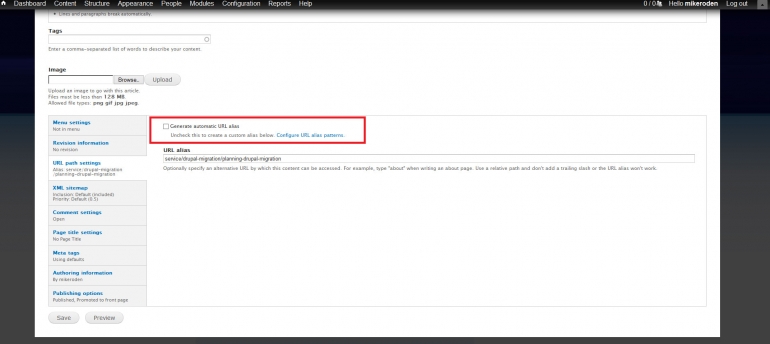Configuring Drupal SEO
Laying the foundation for a search-engine-friendly Drupal site involves a high level of technique and strategy. Drupal SEO out-of-the-box is made easy with a solid groundwork for on-going optimization efforts. However, this only scrapes the surface of what you can do to optimize your site effectively.
The Basics
Site Name - Initially configuring site during installation is the first opportunity to give your site a unique name. Later on, users may modify this name via the Configuration manager. Once set, the site name will automatically appear in the header, page title, browser tabs, and system generated e-mails. Page titles should reflect the brand, and are shown in the SERP for your page. Human and robots both rely on these titles when it comes to identifying the nature of your site.
Slogan - Drupal allows for the display of a slogan next to the site name or underneath logos (along with other areas, depending on the installed theme). Slogans present as another great opportunity to mix in target keywords. This field will factor into your efforts to push ahead in the rankings, not to mention add a little flair to your page.

Adding a slogan to your website is simple:
1. Access the admin dashboard of your Drupal site.
2. Click on the Configuration link on the admin navigation menu at the top of the page.
3. In the System section of the page, click on the link labeled Site information.
4. Enter the text you want to use in the field marked Slogan.
5. Click on the Save configuration button.
Search Engine Friendly URLs
Next on the list is ensuring that your URLs are Search-Engine Friendly (SEF). Optimizing URLs is double value in making site addresses readable for crawlers and surfers. Without some love from the installer, URLs from Drupal will look something like this by default:
http://www.webcommune.com/?q=node/6
Not conducive to human engagement, and especially not helpful in terms of SEO. Much easier on the eyes and circuits alike, is this:
http://www.webcommune.com/portfolio
Luckily, Drupal has got you covered when it comes to being able to produce SEF URLs like the one just above. Clean URLs and the Path module will allow users to create custom, readable URLs. With Drupal 7, the automatic installer will attempt to apply these features during installation. With these enabled, Drupal will generate a URL alias based off the title of the page.
Clean URLs may be accessed from the dashboard by clicking Configuration>Search and MetaData>checking "Enable Clean URLs"
PathAuto may be enabled from the dashboard by clicking on Modules>Scrolling Down to "Path">checking the module>clicking on the "Save Configuration" button

Custom URLs
Plenty of SEO "experts" occupy the Earth, each with their own discrepancies when it comes to Drupal SEO and SEO in general. One thing all agree on, is how URLs influence the way search engines view and inevitably categorize a content item. With your site set to Clean URLs with the Path Module enabled, you will have total control over your URL aliases. Note than automatically generated URLs are able to be modified, and this behavior is encouraged for the purposes of Drupal SEO.
For a holistic view of URL aliases, including the option to edit them, users can click Configuration>Search and Metadata>Selecting URL Aliases. From this screen admins can make edits, and naturally, not forget to save them!

Discussed were the basics of getting your site up and running, and ready for the big leagues. Drupal SEO is an ongoing process, though these steps really set the stage for new sites. The next steps at the top of your list should be setting up Taxonomy, Tagging, Menu Attributes, and other important modules. Drupal SEO is best rounded out and completed with the SEO Checklist Module, available from Drupal.org.
About the author
Copyright © . All Rights Reserved
